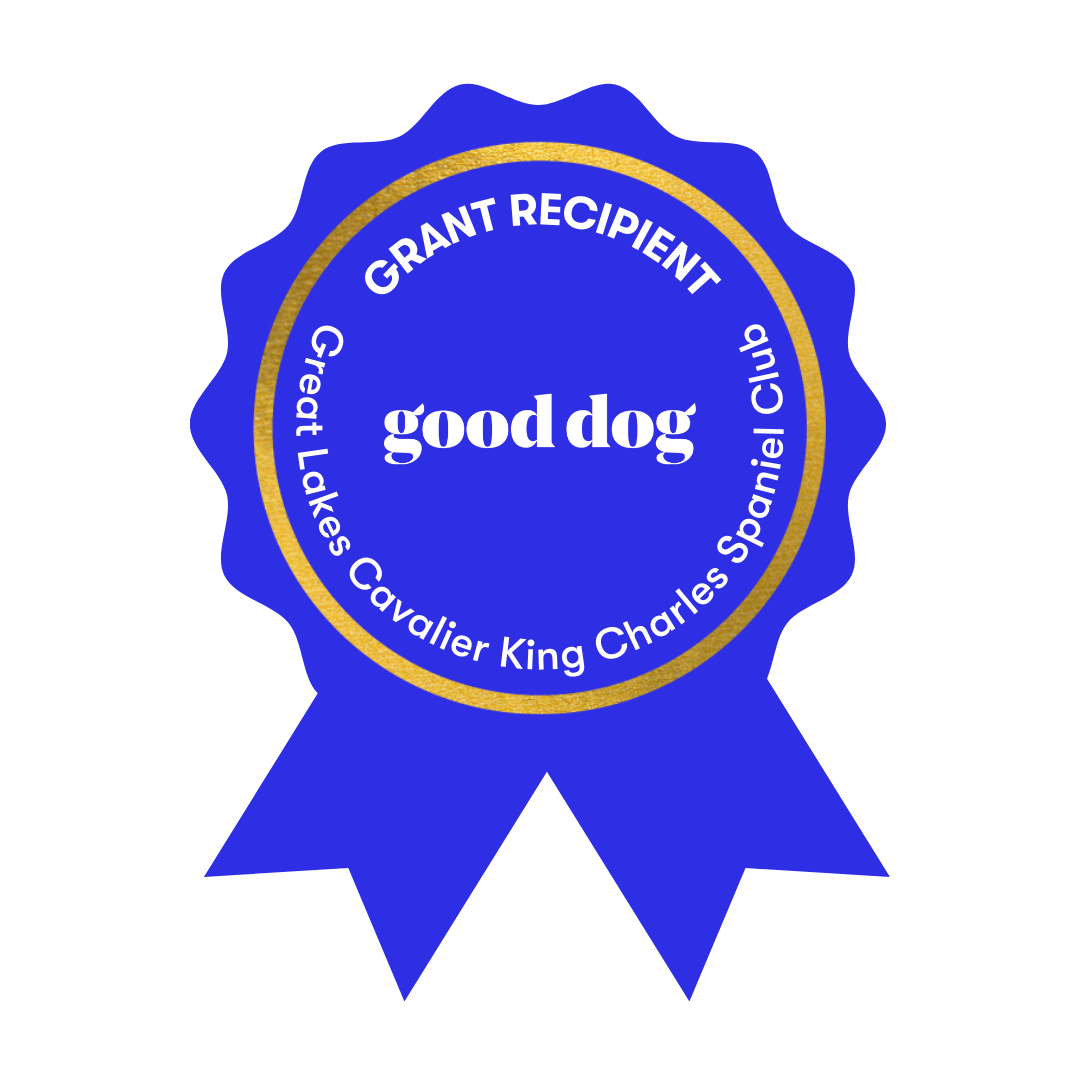
Great Lakes Cavalier King Charles Spaniel Club, Inc.
To Represent, Protect, and Promote the Cavalier in Greater Michigan
Cavalier Health Summary

HEALTH WARNING FOR ALL DOG LOVERS…READ Xylitol Toxicity in Dogs This sweetener is present in many diet foods, chewing gum and toothpaste products.
Now onto specific health issues in this beautiful breed…
The Cavalier King Charles Spaniels are generally healthy, sturdy small dogs. However, as with many other breeds, there are health concerns. The number one health concern is a form of degenerative valve disease called Mitral Valve Disease (MVD). Please take time to review this health summary.
Interesting to note at the start of this summary-
The findings from surveys performed by the late George A. Padgett, DVM, Veterinary Pathologist & Professor Emeritus, College of Veterinary Medicine, Michigan State University and author of Control of Canine Genetic Diseases: Mixed-breed dogs have more genetic diseases than purebred dogs. There are 215 known diseases in mixed breed dogs, with 71 percent of them having defective genes. The idea that a mixed-breed dog is likely to have less genetic diseases than a purebred is a misconception.
Cavalier Clubs throughout the world are active in fighting diseases and disorders in this beloved breed by providing health clinics, funding breed specific research and delivering breed education programs.
Mitral Valve Disease: The number one health issue in Cavalier King Charles Spaniels is Mitral Valve Disease (MVD). MVD is an acquired disease of the heart. In this disease, the valve thickens and degenerate thus leading to congestive heart failure. This form of degenerative valve disease could eventually induce terminal cardiac failure and resulting death. It is important to note, that many Cavaliers live to old age with MVD in various stages.
The Following Two Excerpts from Degenerative Valve Disease by: Dr. Robert Prošek*
“Degenerative valve disease accounts for about 75% of cardiovascular disease in dogs. Approximately 60% of affected dogs have degeneration of the mitral valve, 30% have lesions in both the tricuspid and mitral valve leaflets, and 10% have only tricuspid valve disease. In dogs, the disease is age and breed-related, with older, small-breed dogs demonstrating a higher incidence. There is also a slight predisposition among male dogs.” *
“Although MVD is common in toy breeds, it is of particular concern in Cavaliers because they may exhibit early onset of the disease with a more rapid progression. In addition to the Cavaliers, Miniature poodles, Cocker Spaniels, Miniature Schnauzers, Terriers and Dachshunds are the most commonly affected breeds. Larger breeds are affected by mitral valve disease although less frequent.” *
Breeding Recommendations to address MVD:
Breeders are strongly advised to have board certified specialists screen for early onset of this disease before breeding their Cavaliers.
PSOM: A recent report in the veterinary literature has documented an otitis media (middle ear infection) that appears to affect the CKCS breed in particular. Due to the mucoid nature of the ear disease the condition has been referred to as primary secretory otitis media (PSOM) or “glue ear.” Clinical signs of PSOM may not be presented (referred to as sub-clinical). If clinical signs are present, they may include hearing loss, neurological signs (facial paralysis, head tilt, involuntary eye movement, and circling, unsteady and clumsy walking patterns), neck scratching and head shaking. The sample study indicated 40% of the study group had PSOM. A veterinary dermatologist treats this disorder by flushing the affected ear.
Syringomyelia (sear-IN-go-my-EEL-ya): This is a disorder in which a cyst forms within the spinal cord. SM causes a wide variety of neuropathic symptoms due to damage of the spinal cord. PAIN is the most important clinical sign of the disorder. It appears in many species including dogs and especially in majority of toy breeds. SM in Cavaliers has been identified by researchers and small population samples have been explored.
Syringomyelia has been reported as one of the most common spinal cord disorders of toy breed dogs and has been documented in the Cavalier King Charles Spaniel, King Charles Spaniel, Griffon Bruxellois, Yorkshire Terrier, Maltese Terrier, Chihuahua, Miniature Dachshund, Miniature and Toy Poodle, Bichon Frise, Pug, Shih Tzu, Pomeranian, Staffordshire Bull Terrier, Boston Terrier, Pekingese, Miniature Pinscher, and French Bulldog. Prevalence in other breeds including random bred (mixed breeds/mutts) has not been measured at this time. Radiologists have anecdotely reported that these cysts are atypical findings in all breeds including purebred and mixed breeds/mutts.
Background: There is a suggestion the SM in Cavaliers might have dominant with incomplete penetrance inheritance and breeders should look for overt clinical cases in their pedigrees. SM causes a wide variety of neuropathic symptoms due to damage of the spinal cord. PAIN is the most important clinical sign of the disorder. Cavaliers producing SM in their offsprings should be tracked even if MRI normal. More genetic hypotheses and well-designed research is indicated to select health screening tools that have true predictive values in the area of inheritance of SM in Cavaliers. The ACKCS Charitable Trust continue to fund research in this disorder.
Platelets: Cavaliers can have idiopathic asymptomatic thrombocytopenia, which is an atypically low number of blood platelets and/or macrothrombocytosis, which is atypical large platelets. Cavaliers with large platelets have psuedo-thrombocytopenia. This is not a disease and it is not consider problematic. Because of the prevalence of large platelets in Cavaliers, it is recommended to have veterinarians manually count platelets (by hand instead of machine).
Eyes: Cavaliers do not generally suffer from any serious eye problems. They can inherit juvenile cataracts, retinal dysplasia, and other eye diseases.
Breeding Guidelines for Eyes: Breeders must screen their Cavaliers with board certified veterinarian ophthalmologists and only breed Cavaliers that fall within normal limits or with CERF breeder options.
Periodontal Disease: Most Cavaliers will develop some form of periodontal (gum) disease at a relatively early age. Theories abound about why this occurs and the answer probably lies in a combination of factors of their immune response and the present of bacterial plague.
Patellas: Another area of concern is luxating patellas (slipping kneecaps). Toy breeds are very prone to lateral luxating patellas. Patellar luxation is most common in Poodles, Yorkshire Terriers, Pomeranians, Pekingese, Chihuahuas, Miniature Pinschers and Boston Terriers. Females have the highest risk for this condition.
- Diagnosis is relatively simple for a veterinarian familiar with orthopedics. It involves palpation of the joint and manual luxation of the patella. Care must be exercised with the examination to avoid injuring the joint, or making an incorrect diagnosis. Patellar luxation may be classified in four grades, with grade I being the mildest. This grading system is subjective so it is important in the present of luxation to have the same veterinarian perform the follow-up screening. Mild patellar luxation (grade 1-2) may be discovered as an incidental finding especially in a growing dog or a female in season. In addition, patellar luxation may occur in any breed because of trauma.
- Pain is usually not associated with this condition unless it is the result of trauma or until degenerative arthritis has occurred due to chronicity of disease.
- The treatment and long-term outcome (prognosis) depend on the severity of disease. Severity is determined how often the kneecap slips out of place, and how easily it slips back into the normal position. Treatment is based upon severity of signs and the affected Cavalier’s age, breed and weight. Conservative therapy (non-surgical) and veterinary observation is often the treatment of choice. However, if the patellar luxation has persistent lameness, or other knee injuries occur secondary to the luxation, then surgery intervention needs to be evaluated.
Breeding Guidelines for Patellas: Cavaliers used for breeding should have within normal limits patellas as determined by an OFA examination at age one. The patellas should be re-evaluated as the Cavalier’s ages.
Canine Hip Dysplasia*:
“Dysplasia comes from the Greek words dys, meaning “disordered” or “abnormal”, and plassein meaning “to form”. The expression hip dysplasia can be interpreted as the abnormal or faulty development of the hip. Abnormal development of the hip causes excessive wear of the joint cartilage during weight bearing, eventually leading to the development of arthritis, often called degenerative joint disease (DJD) or osteoarthritis.” *
“The terms DJD, arthritis and osteoarthritis are used interchangeably. Today, the general veterinary consensus is that hip dysplasia is hip joint laxity resulting in osteoarthritis.” *
“CHD in its severest form can be diagnosed by clinical signs, but it usually requires radiographic evidence of hip joint laxity and/or the appearance of DJD to arrive at a definitive diagnosis.” *
- An affected dog may have one or any combination of the following clinical signs: *
- Presentation: 5 months to 12 months for the severe form of hip dysplasia; later for the chronic form
- Abnormal Gait
- Bunny-hopping When Running
- Thigh Muscle Atrophy (loss of muscle mass)
- Pain
- Low Exercise Tolerance
- Reluctance to Climb Stairs
- Audible “click” When Walking
- Increased Intertrochanteric Width (”points of hips” are wider than normal)
“Clinical signs by themselves do not necessarily mean that a dog has hip dysplasia, other conditions of the hip can mimic CHD. A radiograph is essential for a more accurate assessment of the dog’s hip joint integrity.”* If performing the extended view procedure (OFA) alone, it is recommended to have an additional radiograph be taken at age 5 to confirm the dog truly does not have CHD. *Source: http://www.pennhip.org
Breedings Guidelines for Hips: Current research indicates radiologic screenings for hips by extended view at age 2 years of age should be repeated as the dog ages at over 5 years of age to gain a true profile on the dog.
Episodic Falling (EF): This disorder is an exercise-induced hypertonicity disorder meaning that there is increased muscle tone and the muscles are unable to relax. Episodic falling is a neurological condition, induced by exercise, excitement or frustration, in which muscle tone increases. This means the dog is unable to relax its muscles, becomes rigid and falls over.
Affected dogs usually start to demonstrate clinical signs before one year of age, with most cases having their first episode aged four to seven months. Early in 2011 Geneticists at the Animal Health Trust identified a recessive mutation associated with Episodic Falling. Episodic Falling syndrome is often difficult to diagnose as the syndrome can show similarities to other neurological conditions, such as epilepsy. A DNA test has been developed which will provide a useful diagnostic tool to the veterinary profession and dog breeders. The test will be available from 18th April 2011.
Breeding Guidelines: Breeders using the test will be sent results identifying their dog as belonging to one of three
categories-
CLEAR: these dogs have two normal copies of DNA. Clear dogs will not develop EF as a result of the identified mutation. We cannot exclude the possibility that some dogs may show some clinical signs similar to those of EF but due to a different genetic or clinical cause.
CARRIER: these dogs have one copy of the mutation and one normal copy of DNA. These dogs will not develop EF themselves but they will pass the mutation on to approximately 50% of their offspring. We cannot exclude the possibility that some dogs may show some clinical signs similar to those of EF but due to a different genetic or clinical cause.
AFFECTED: these dogs have two copies of the EF associated mutation and are likely to present clinical signs of EF during their lifetime, with an age of onset of around 4-7 months. EF is a highly variable condition. Our research indicates that some dogs with the EF associated mutation will not show clinical signs of EF.
Owners and breeders can access the DNA tests for dry eye and curly coat and episodic falling, from 18 April 2011, through the AHT’s online DNA testing webshop at: http://www.ahtdnatesting.co.uk/
Fly Catcher’s Syndrome: This disorder is not really a syndrome. Fly-biting or fly-snapping are terms used to describe peculiar episodes where the dog appears to be snapping at imaginary flies.
To read more: http://www.canine-epilepsy.net/flybite/flybite.html
Breeding Guidelines: Do not breed dogs exhibiting Fly Catcher’s Syndrome’s symptoms.
DISCLAIMER: This general education information was used with permission of Kathryn Yonkers, http://www.stuarthome.net/cavalierhealth.cfm. The information provided on this page and the original link is not intended as veterinary medical advice or to take the place of professional guidance. Please seek the services of a competent veterinarian at the first indication of any problems or concerns.


